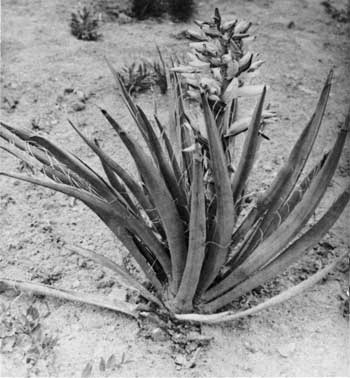|
BANDELIER National Monument |
 |

The useful yucca plant.
Origins of the People
DROUGHT AND MIGRATIONS. It seems, however, that the gods were fickle. Some two centuries of growth and prosperity were all that were to be allowed the farmers of the Great Pueblo centers. In the last quarter of the 13th century, a period of drought came to the high plateaus of the Pueblo people. From the evidence of the tree rings of the time, the majority of the years between A. D. 1276 and 1299 were so deficient in rainfall that the Indian corn crops could not have matured. Although this drought was not actually continuous, and varied between regions, there was undoubtedly much starvation, and a decimation of the inhabitants of the great towns, perhaps from enemy raids as well as hunger. There were undoubtedly numerous migrations from the drought-stricken areas into places with reliable streams.
These troubled times in the western centers and emigrations therefrom were responsible in large part for the settling of the Pajarito Plateau and the canyons of what is now Bandelier National Monument. The streams of the Jemez Mountains continued to flow during the dry time, apparently, for large-scale colonization of well-watered canyons such as Frijoles appears to date from the end of the 13th century. The drift of the emigrants from the western areas is impossible to trace in detail, continuing as it did for several generations and originating from many sources. The Bandelier region may have been something of a melting pot, assimilating migrants from various distant places. A study of the pottery types produced in the early days of residence here affords the best clue to possible origins. Among these types are found precise copies of decoration styles from a number of the western centers, indicating that the women potters carried on their respective traditional decorations upon arrival in their new homes. One particular kind of black-on-white pottery can hardly be distinguished even by microscopic examination from a similar ware made in the Mesa Verde country.

|

|
|
Last Modified: Sat, Jan 6 2001 10:00:00 am PDT |


